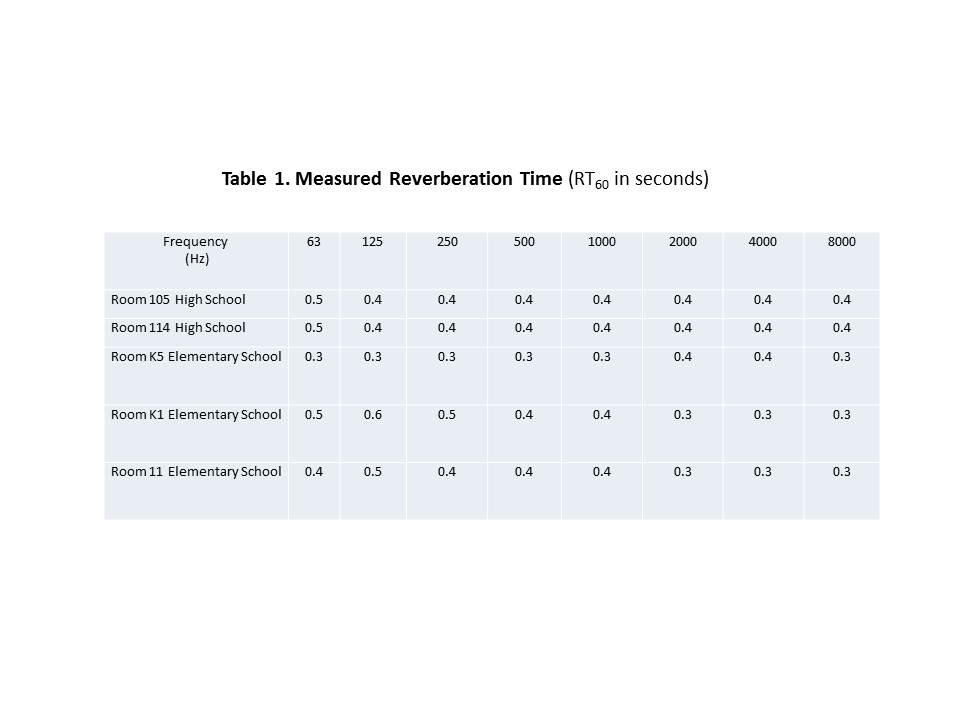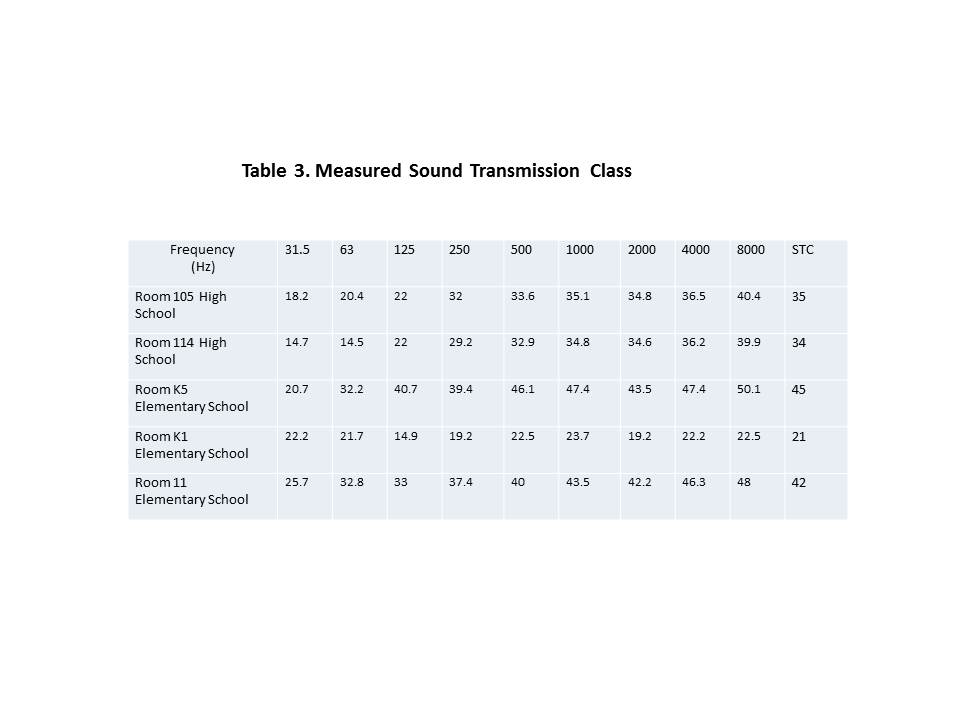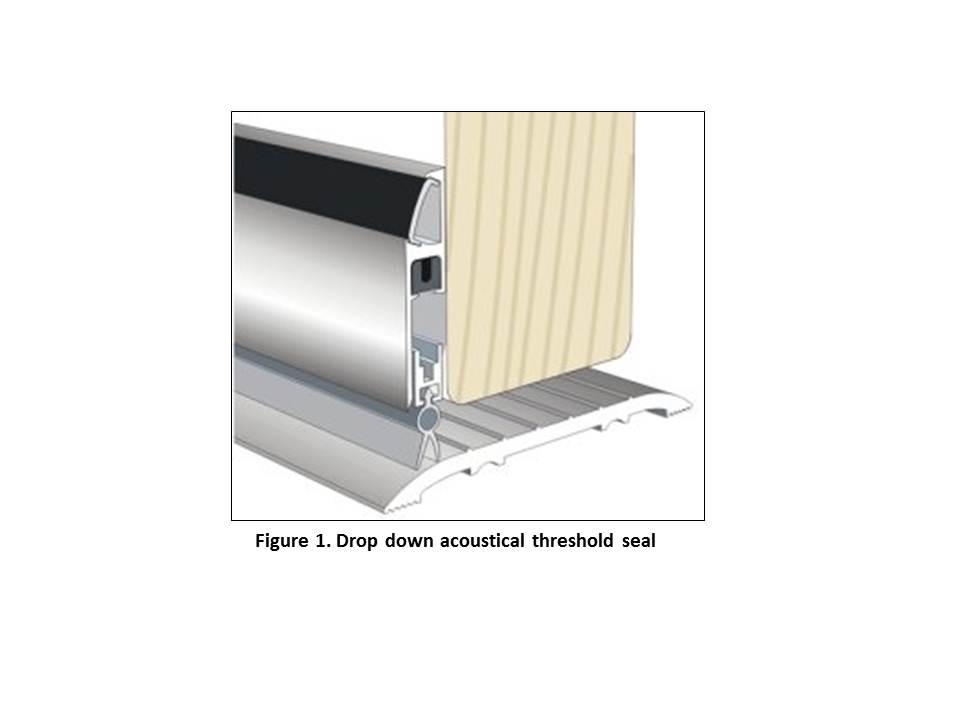Introduction
David Coate Consulting (DCC) conducted acoustical testing on February 23, 2012 in several classrooms in both the North Smithfield Rhode Island High School and Elementary School. The main focus of this study was to determine whether or not the unit ventilators meet relevant noise standards. The specific acoustical characteristics of individual classrooms are also important since they can affect unit ventilator noise levels and/or speech intelligibility.
The ANSI S12.60-2002 Classroom Acoustics Standard was used as the basis of this study. This standard calls for measurement of background noise due to unit ventilators, the reverberation time of the rooms, and the transmission loss of walls dividing classrooms from activity areas such as hallways. The ANSI Classroom Acoustics Standard was developed to address the fact that verbal communication and accurate listening conditions are critical for the classroom learning experience.
Reverberation
Reverberation in classrooms and other teaching spaces is essentially the effect of sound reflecting off various hard surfaces within the space. The net effect of reverberation, a combination of many echoes, is perceived as a longer incoherent or ‘blurry’ echo that can interfere with speech communication. Reverberation time is typically measured in octave bands and is designated RT60, or the time it takes sound levels to decay 60 decibels (dB). In general, the larger the room, the greater the reverberation time. Speech interference increases with increasing reverberation time.
The ANSI S12.60-2002 Classroom Acoustics Standard specifies that the RT60 for classrooms should be at or below 0.6 seconds for small classrooms and 0.7 seconds for mid-size classrooms, for the upper mid-frequencies (500, 1000, and 2000 Hz). Small classrooms are defined as less than 10,000 ft3 and mid-sized classrooms are defined as greater than 10,000 ft3 but less than 20,000 ft3. The ANSI standard does not delineate RT60 values for learning spaces greater than 20,000 ft3 but instead provides more general guidelines. I measured the RT60 at a number of locations within each space tested, and then averaged the results. Reverberation time can vary both spatially and temporally because of a number of factors including room geometry and therefore averaging is important. Table 1 shows the results of these tests.

Measured reverberation times meet the ANSI standard for all classrooms tested. All of the rooms tested had acoustical ceiling tiles (ACT) which provides enough sound absorption to meet the RT60 standard.
Background Noise
Background noise in classrooms can be problematic if background noise levels are sufficiently high. High background noise levels can reduce the signal to noise ratio needed to properly understand verbal communication. That is, if high enough, background noise can mask speech or cause it to be unintelligible. The ANSI standard calls for background noise (e.g., caused by HVAC systems) to be at or less than 35 dBA.
As shown in Table 2, all the rooms tested failed the background noise test. In all rooms tested, the unit ventilators generated noise levels in excess of 35 dBA, by as much as 6 to 9 dBA. By way of context, a 3 dBA increase is barely noticeable, a 5 dBA increase is substantial, and a 10 dBA increase is perceived as a doubling in loudness. While these unit ventilators exceed the ANSI standard by a substantial margin, many schools with unit ventilators experience noise levels in this general range.
Each room was also tested with the unit ventilators off. Under that condition Room 105, Room 114, and Room K1 tested below the 35 dBA limit while Room K5 and Room 11 tested above the 35 dBA limit. With unit ventilators off, exhaust fan and water valve noise was audible in Room K5. With the unit ventilator off, exhaust fan noise was very audible in Room 11.
The high fan speed on the unit ventilators results in approximately 3 dBA higher noise levels than on the low speed setting.

Wall Noise Reduction
Transmission Loss (TL) or Noise Level Reduction (NLR) , is the amount of noise reduction a wall or other partition provides. For classrooms with corridors adjacent to the space, ANSI recommends a minimum Sound Transmission Class (STC) of 45. Table 3 shows the measured results for each room. These particular STC measurements were for the classroom walls between the classroom and adjacent corridor.

As can be seen from this table, only Room K5 met the ANSI STC 45 criterion. However, these particular walls are quite robust, consisting of at least six inch thick masonry and the low STC results are very likely due to sound leaks around the perimeter of classroom doors.
A six inch thick masonry wall should readily achieve STC 45 or greater. Consequently, very simple and inexpensive means of sealing the doors in these rooms will likely increase the overall STC to 45. The recommendations section provides details on how to seal these doors.
Recommendations
Sound Absorption Treatments
Since all of the tested learning spaces pass the RT60 test, no additional sound absorption treatments are needed.
Unit Ventilators
The unit ventilators failed the background noise test in all rooms tested. In addition, exhaust fans (that could not be turned off) failed the background noise test in certain rooms.
While retro-fit noise control measures for the unit ventilators may be possible, the costs of doing so may be higher than replacing the units with modern ones that are specified to meet the 35 dBA limit. On the other hand, installation of new HVAC equipment to meet stringent noise limits can also be expensive and in some cases impractical from an engineering perspective.
However, even if the unit ventilators were replaced or retrofit to meet the 35 dBA limit, certain rooms in the Elementary school with separate exhaust fans would still be above the 35 dBA limit and would require additional sound reduction. In many cases, excessive exhaust fan noise is caused by high face airflow velocity. In such cases, increasing duct size can reduce airflow velocity and noise levels. In line duct silencers can sometimes be installed. However, this retrofit approach can be costly.
Wall Noise Reduction
All of the tested learning spaces except room K5 failed the important STC test, but all of the tested walls would likely meet this requirement if the doors were properly sealed and treated.
The walls in this building are 6” or 8” thick solid concrete masonry which would be at STC 45 or greater. Since the STC values for the walls separating classrooms from corridors are currently limited by sound coming through the doors, proper sealing of the doors should achieve a composite wall/door sound isolation of STC 45. This can be achieved by using rubber bulb type gasketing around the door perimeter, and a drop down metal and rubber acoustical seal at the bottom of the door (as shown in Figure 1). A test of the adequacy of the seal is if any light can be seen coming through the door perimeter when the room is completely dark, and with a bright light on in the hall.

These recommendations assume solid core doors. However, doors with inset glass lites would need additional treatments to improve the composite wall/door sound isolation to STC 45. The door would either have to be replaced with a standard solid core door or, ¼” laminated glass would need to be added as an additional frame to improve the transmission loss through the glass portion of the door.